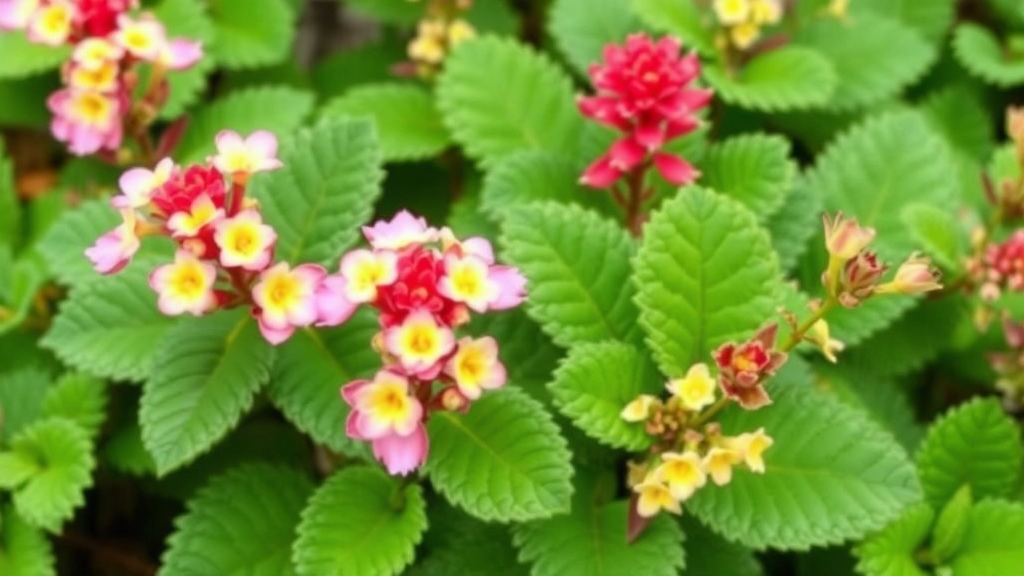Exploring Kalanchoe Varieties
When it comes to exploring the different types of Kalanchoe, the variety is truly astounding. As a plant enthusiast, I’ve come across many Kalanchoe species, each with its unique charm. From the vibrant flowering varieties that brighten up any space to the unique foliage types that add a touch of greenery, there’s a Kalanchoe for every taste and gardening style.
My Favorite Kalanchoe Varieties
One of my favourites has to be the fuzzy Kalanchoe, like the Panda Plant, which adds a whimsical touch to any collection. For those who prefer low-maintenance plants, the drought-tolerant Kalanchoe varieties are perfect. Whether you’re an indoor gardener or looking to spruce up your outdoor space, there’s a Kalanchoe variety that fits the bill.
Diving into the World of Kalanchoe
Let’s dive into the world of Kalanchoe and discover what makes each type special.
Common Flowering Varieties of Kalanchoe
When you think of Kalanchoe, do you picture vibrant blooms that light up your space? Many people are drawn to these plants for their stunning flowers, but which varieties are the most common?
Kalanchoe is not just a single type of plant; it encompasses a range of species, each with its unique charm. Here are some of the most popular flowering varieties that you might want to consider:
- Kalanchoe blossfeldiana: Often known as the Flaming Katy, this variety showcases clusters of small flowers in various shades, including red, pink, orange, and yellow. It’s a favourite for indoor décor. Learn more about caring for Kalanchoe Flaming Katy.
- Kalanchoe luciae: Commonly referred to as the Paddle Plant, it features large, paddle-shaped leaves that turn a stunning red when exposed to bright sunlight. Its flowers are small but charming, adding to its appeal. Discover expert tips for Kalanchoe Paddle Plant care.
- Kalanchoe thyrsiflora: Also known as the Mother of Thousands, this variety produces tall flower spikes adorned with small yellow blooms, making it a striking addition to any garden.
- Kalanchoe marnieriana: Known for its unique leaf shape and vibrant yellow flowers, this variety is perfect for those looking to add a touch of the exotic to their collection.
These flowering varieties are not only visually appealing but also relatively easy to care for, making them suitable for both novice and experienced gardeners alike.
Unique Foliage Types in Kalanchoe

Have you ever noticed how some plants just stand out because of their leaves? Kalanchoe is a perfect example.
These plants aren’t just about their stunning flowers; their foliage can be equally captivating.
Varieties That Catch the Eye
- Kalanchoe thyrsiflora (Mother of Thousands)
- Known for its large, paddle-like leaves.
- The edges often turn a lovely red in bright light.
- Kalanchoe luciae (Flapjacks)
- Features thick, flat leaves that resemble pancakes.
- They can create a vibrant display with their red-tipped edges.
- Kalanchoe beharensis (Panda Plant)
- Has fuzzy, velvety leaves that are a delight to touch.
- The leaves have a unique shape, resembling a panda’s ears.
Why Foliage Matters
Unique foliage types not only add visual interest but also tell you a lot about the plant’s growing conditions.
- Texture: Some leaves are smooth, while others are fuzzy or waxy.
- Shape: Varied shapes can create a dynamic look in your garden or home.
Caring for Unique Foliage
To keep these beauties thriving, here are some quick tips:
- Light: Most Kalanchoe love bright, indirect sunlight.
- Watering: Let the soil dry out between waterings to prevent rot.
- Humidity: They prefer drier conditions, so avoid overly humid spots.
Fuzzy Kalanchoe Varieties: Panda Plants and Beyond
When exploring the enchanting world of Kalanchoe, one cannot overlook the fuzzy varieties that add a unique texture to your collection. These plants often leave enthusiasts wondering about their care and characteristics.
Fuzzy Kalanchoe Varieties
Among the most popular fuzzy varieties is the Panda Plant (Kalanchoe tomentosa). Known for its soft, velvety leaves adorned with distinctive brown edges, this plant is a charming addition to any indoor garden.
Other fuzzy Kalanchoe varieties include:
- Kalanchoe beharensis: Also known as the Elephant Bush, this variety features thick, fuzzy leaves that can grow quite large.
- Kalanchoe luciae: Often referred to as the Paddle Plant, it has a unique shape with a soft texture that invites touch.
Care Tips for Fuzzy Kalanchoe
- Light: These plants thrive in bright, indirect sunlight.
- Watering: Allow the soil to dry out completely between waterings to prevent root rot.
- Humidity: They prefer dry conditions, making them suitable for most indoor environments.
Why Choose Fuzzy Kalanchoe?
Fuzzy Kalanchoe varieties are not just visually appealing; they also offer a tactile experience that can be quite satisfying. Their unique textures can serve as conversation starters and add a playful element to your plant collection.
If you’re interested in learning more about the care of these unique plants, check out our Kalanchoe tomentosa care tips and growing guide. For those who prefer a different fuzzy variety, our Kalanchoe beharensis variegata care guide offers detailed insights.
Drought-Tolerant Kalanchoe Varieties
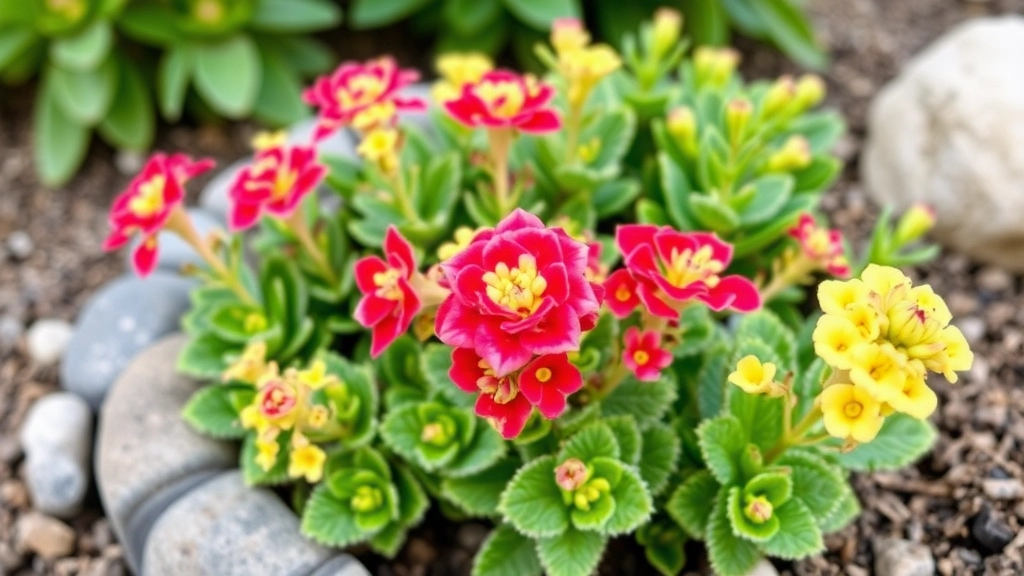
Are you tired of constantly watering your plants, only to find them wilting anyway?
Drought-tolerant Kalanchoe varieties are a fantastic solution for those seeking low-maintenance, resilient houseplants.
These varieties thrive in dry conditions, making them perfect for busy lifestyles or less-than-perfect gardening environments.
Key Drought-Tolerant Varieties
- Kalanchoe tomentosa (Panda Plant):
- With its fuzzy leaves, this variety not only looks unique but also stores water well.
- It can go weeks without water, making it an ideal choice for forgetful gardeners.
- Kalanchoe beharensis (Paddle Plant):
- Known for its large, paddle-shaped leaves, this plant can withstand long periods of drought.
- Its thick leaves enable it to retain moisture effectively.
- Kalanchoe luciae (Flapjack Plant):
- This succulent features striking, flat leaves that store water efficiently.
- It thrives in full sun and requires minimal watering.
Care Tips for Drought-Tolerant Kalanchoe
- Soil: Use well-draining soil to prevent root rot.
- Watering: Allow the soil to dry out completely between waterings.
- Light: Position in bright, indirect sunlight to maximise growth.
Kalanchoe with Distinctive Leaf Shapes
When exploring the captivating world of Kalanchoe, one cannot overlook the allure of its distinctive leaf shapes. These unique foliage forms not only add character to your collection but also serve as conversation starters among plant enthusiasts.
Why Leaf Shape Matters
Are you tired of the same old plant shapes cluttering your space? Kalanchoe offers a refreshing variety that can transform your indoor or outdoor garden.
- Variety in Design: Different leaf shapes can complement various decor styles, from modern minimalism to rustic charm.
- Visual Interest: Unique leaves can draw attention, making your Kalanchoe a standout piece.
- Functional Benefits: Some leaf shapes may aid in water retention, making them more resilient.
Notable Kalanchoe Varieties with Unique Leaf Shapes
- Kalanchoe luciae (Paddle Plant)
- Shape: Thick, paddle-like leaves that form rosettes.
- Highlight: The leaves can take on a beautiful red hue when exposed to sunlight.
- Kalanchoe beharensis (Elephant Bush)
- Shape: Large, elongated leaves with a soft, velvety texture.
- Highlight: Its unique silhouette resembles an elephant’s ear, adding an exotic touch.
- Kalanchoe thyrsiflora
- Shape: Broad, flat leaves that grow in tiers.
- Highlight: The layering creates a stunning visual effect, especially when in bloom.
- Kalanchoe manginii (Chandelier Plant)
- Shape: Long, narrow leaves that hang downwards.
- Highlight: This variety is perfect for hanging baskets, offering a cascading effect.
- Kalanchoe tomentosa (Panda Plant)
- Shape: Fuzzy, oval leaves with a distinctive edge.
- Highlight: The soft texture and unique markings make it a favourite among collectors.
These distinctive leaf shapes not only enhance the aesthetic of your space but also reflect the diversity within the Kalanchoe family. For a deeper dive into the care of specific varieties, check out our guide on Kalanchoe Paddle Plant care or explore the unique features of the Kalanchoe Panda Plant.
Rare and Unusual Kalanchoe Species
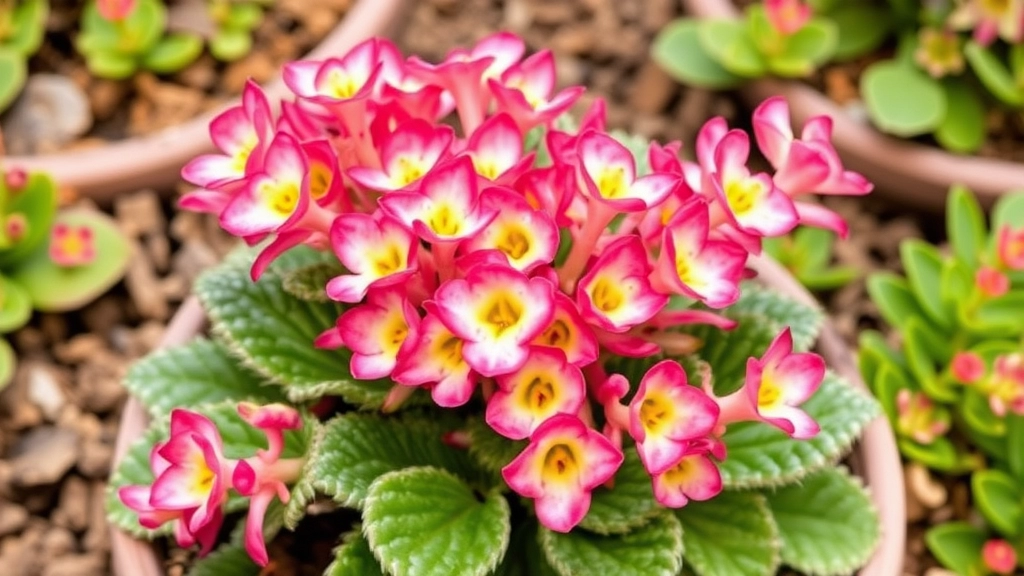
Ever found yourself wandering through a garden centre, mesmerised by the unique shapes and sizes of Kalanchoe?
You’re not alone!
While the common varieties are stunning, the rare and unusual Kalanchoe species can take your collection to the next level.
These plants often come with fascinating characteristics that make them stand out.
Unique Features of Rare Kalanchoe
- Kalanchoe marmorata: Also known as the ‘Pencil Plant,’ it boasts striking mottled leaves that look like nature’s artwork.
- Kalanchoe luciae: Commonly called the ‘Flapjack Plant,’ its large, paddle-like leaves turn a beautiful red when exposed to sunlight.
- Kalanchoe beharensis: Known as the ‘Elephant Bush,’ this one has thick, fuzzy leaves that give it a unique texture.
- Kalanchoe tomentosa: Better known as the ‘Panda Plant,’ it features fuzzy, grey-green leaves with dark spots, making it a favourite among collectors.
Why Collect Rare Kalanchoe?
Collecting rare species can be rewarding.
You get to enjoy:
- Aesthetic Appeal: Their unique shapes and colours can be a conversation starter.
- Collectible Value: Some rare varieties can appreciate in value over time.
- Diverse Care Challenges: They often require different care techniques, which can be a fun challenge for plant enthusiasts.
Tips for Caring for Rare Kalanchoe
- Light Requirements: Most rare Kalanchoe thrive in bright, indirect sunlight.
- Watering: Allow the soil to dry out completely between waterings.
- Soil Type: Use well-draining soil to prevent root rot.
- Temperature: Keep them in a warm environment, ideally between 18°C and 24°C.
Best Kalanchoe Varieties for Indoor Gardening
When considering the best Kalanchoe varieties for indoor gardening, many of us wonder which types will thrive in our homes while adding a touch of beauty.
Kalanchoes are renowned for their resilience and vibrant blooms, making them a fantastic choice for indoor spaces. Here are some top picks that not only survive but flourish indoors:
Large-Leaf Kalanchoe Varieties: A Visual Appeal
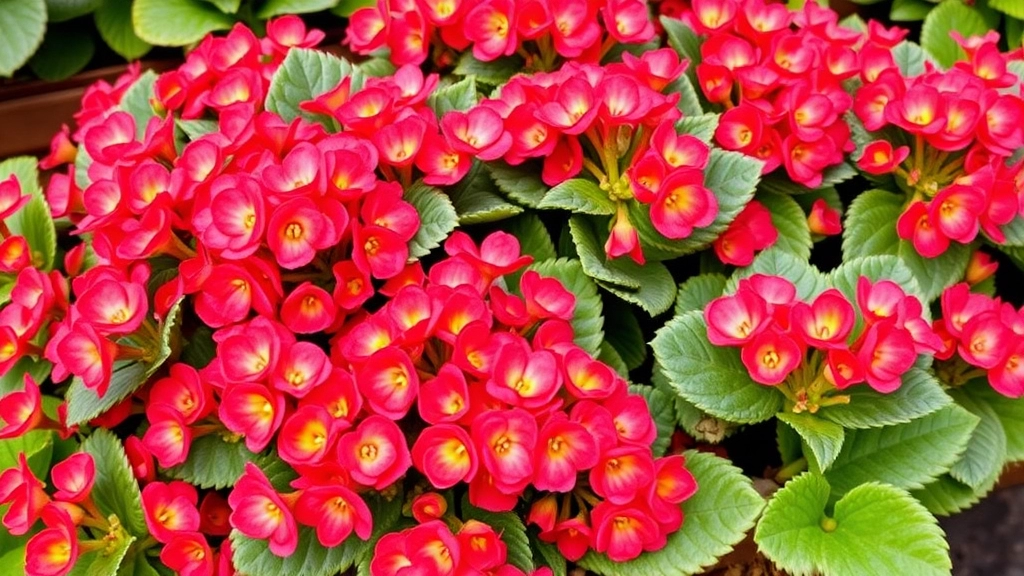
Have you ever walked into a room and been instantly captivated by a plant’s sheer size and beauty?
Large-leaf Kalanchoe varieties are show-stoppers in any indoor or outdoor setting.
These plants not only bring a lush, tropical vibe but also serve as a focal point in your space.
Here’s why you should consider adding them to your collection:
- Visual Impact: The broad leaves create a striking silhouette, making them perfect for a statement piece.
- Low Maintenance: Despite their size, they’re surprisingly easy to care for, making them a great choice for busy folks.
- Diverse Varieties: From the classic Kalanchoe luciae to the stunning Kalanchoe beharensis, there’s a large-leaf variety to suit every taste.
Popular Large-Leaf Varieties
- Kalanchoe luciae (Paddle Plant)
- Known for its thick, paddle-shaped leaves that can take on a beautiful red hue in bright sunlight.
- Kalanchoe beharensis (Elephant Bush)
- Features large, fuzzy leaves that give it a unique texture and a striking appearance.
- Kalanchoe thyrsiflora (Flapjack Plant)
- This one has stunning rosettes of large, flat leaves that are perfect for adding depth to your plant collection.
Tips for Growing Large-Leaf Kalanchoe
- Lighting: They thrive in bright, indirect sunlight. Too much direct sun can scorch those beautiful leaves.
- Watering: Allow the soil to dry out between waterings. Overwatering can lead to root rot.
- Soil: A well-draining cactus mix is ideal to keep the roots healthy.
Why You’ll Love Them
Large-leaf Kalanchoe varieties not only enhance your decor but also boost your mood.
Imagine sipping your morning coffee next to a vibrant plant that brings a bit of the outdoors in.
They’re perfect for anyone looking to add a touch of nature to their home, making them a fantastic choice for indoor gardening.
Hanging Kalanchoe Varieties for Vertical Spaces
Are you struggling to find the perfect plants to elevate your vertical spaces?
Hanging Kalanchoe varieties offer a stunning solution.
These plants not only add a touch of greenery but also thrive in various conditions, making them ideal for both indoor and outdoor settings.
Why Choose Hanging Kalanchoe?
- Space-Saving: Perfect for small areas where floor space is limited.
- Visual Interest: Their cascading growth creates a beautiful display.
- Easy Care: Most varieties require minimal maintenance, making them suitable for all skill levels.
Popular Hanging Varieties
- Kalanchoe tomentosa (Panda Plant)
- Features fuzzy leaves with unique markings.
- Ideal for hanging baskets, as they spill over beautifully. Learn more in the Kalanchoe tomentosa varieties care guide.
- Kalanchoe beharensis (Chandelier Plant)
- Known for its large, thick leaves.
- Grows tall and can create an eye-catching vertical element.
- Kalanchoe marnieriana (Mother of Thousands)
- Produces small plantlets along its edges.
- Perfect for a hanging display that keeps giving. For more details, check out the care and propagation guide of Kalanchoe tubiflora.
Care Tips for Hanging Kalanchoe
- Light: Ensure they receive bright, indirect sunlight.
- Watering: Allow the soil to dry out between waterings to prevent root rot.
- Fertilizing: Use a balanced fertilizer during the growing season for optimal growth.
Popular Paddle-Shaped Kalanchoes
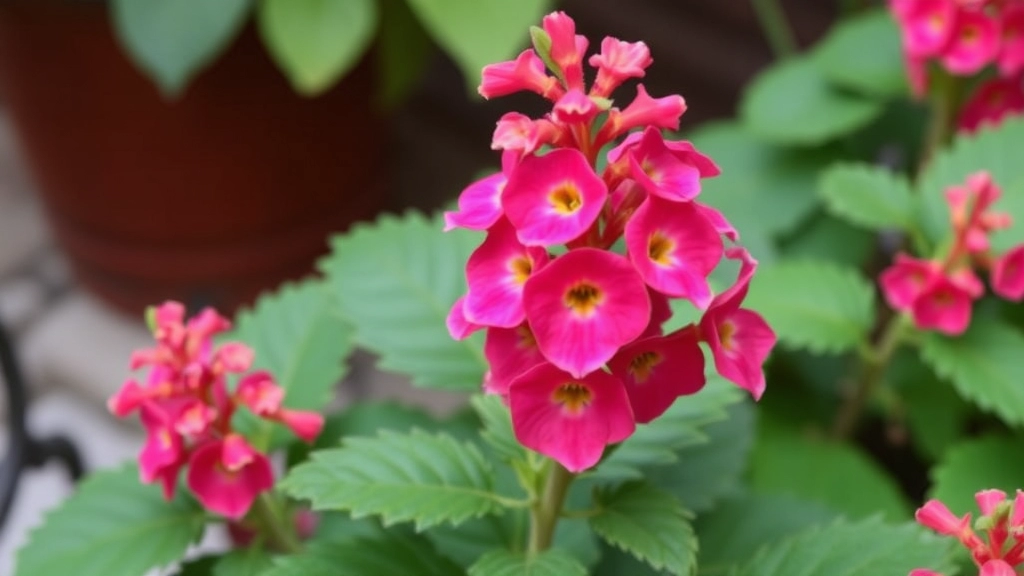
Have you ever wondered why paddle-shaped Kalanchoes are all the rage?
These unique plants, known for their striking leaf shapes, are not just eye-catching but also incredibly easy to care for.
Why Paddle-Shaped Kalanchoes?
Kalanchoes with paddle-shaped leaves, like Kalanchoe luciae (commonly known as the “Paddle Plant”), are perfect for adding a touch of whimsy to your plant collection.
Here’s what makes them stand out:
- Visual Appeal: Their thick, flat leaves resemble paddles, creating a bold statement in any space.
- Easy Care: These plants thrive on neglect, making them ideal for beginners.
- Versatile: They fit well in various settings, from sunny windowsills to outdoor gardens.
Popular Varieties to Consider
If you’re keen to add some paddle-shaped Kalanchoes to your home, here are a few popular choices:
- Kalanchoe luciae: Known for its vibrant red edges, this variety is a showstopper.
- Kalanchoe thyrsiflora: Also called “Flapjack,” it features broader leaves and a lovely green hue.
- Kalanchoe beharensis: This one has a more textured look, with fuzzy leaves that add character.
Care Tips for Paddle-Shaped Kalanchoes
Taking care of these beauties is a breeze. Here’s how to keep them thriving:
- Sunlight: They love bright, indirect light. A south-facing window is perfect.
- Watering: Let the soil dry out completely between waterings. Overwatering is a common mistake.
- Soil: Use well-draining soil to prevent root rot.
Sun-Loving Kalanchoe Varieties for Outdoor Growth
Are you struggling to find the perfect plant that thrives in full sun?
Kalanchoe varieties are a fantastic choice for outdoor gardens, especially in sunny spots.
These succulents not only add vibrant colour but also require minimal care.
Top Sun-Loving Kalanchoe Varieties
- Kalanchoe blossfeldiana
- Known for its bright, clustered flowers.
- Thrives in direct sunlight and blooms throughout the year.
- Kalanchoe luciae (Paddle Plant)
- Features stunning, paddle-shaped leaves that turn red in the sun.
- Grows best in well-drained soil and needs minimal watering.
- Kalanchoe tomentosa (Panda Plant)
- Recognisable by its fuzzy leaves adorned with brown edges.
- Prefers full sun exposure and is drought-tolerant.
- Kalanchoe fedtschenkoi
- Has striking, serrated leaves with a bluish hue.
- Flourishes in sunny areas and is quite resilient.
Care Tips for Sun-Loving Kalanchoe
- Location: Ensure they receive at least six hours of direct sunlight daily.
- Soil: Use well-draining soil to prevent root rot.
- Watering: Allow the soil to dry out completely between waterings.
- Fertiliser: A balanced fertiliser can be applied during the growing season for optimal health.
These sun-loving varieties not only beautify your outdoor space but also provide a low-maintenance gardening experience. For more detailed care tips, check out our guide on optimal light for Kalanchoe and our expert tips for healthy growth of Kalanchoe Paddle Plant.
Are you new to the wonderful world of Kalanchoe and feeling a bit overwhelmed?
Don’t worry; you’re not alone!
Many beginners wonder which varieties are the easiest to care for, especially if you’re juggling a busy lifestyle.
Let’s dive into some Kalanchoe varieties that are perfect for those just starting out.
Kalanchoe plants are fantastic for beginners because they’re resilient, low-maintenance, and offer a burst of colour to any space.
Here are some easy-to-grow varieties you can consider:
– **Kalanchoe Blossfeldiana**: Known for its vibrant flowers, this variety thrives with minimal care. A little sunlight and water go a long way!
– **Kalanchoe Tomentosa (Panda Plant)**: With its fuzzy leaves, it’s not just cute but also forgiving. Just let it dry out between waterings.
– **Kalanchoe Luciae (Paddle Plant)**: Its unique paddle-shaped leaves are a showstopper. It loves bright light and can handle a bit of neglect.
– **Kalanchoe Fedtschenkoi**: This one has lovely silvery leaves and can tolerate low light, making it perfect for indoor spaces.
To keep your Kalanchoe thriving, here are some straightforward tips:
– **Light**: Place your plant in a spot that gets plenty of indirect sunlight. They love it!
– **Water**: Water only when the soil feels dry. Overwatering is a common mistake.
– **Soil**: Use well-draining soil. A cactus mix works wonders.
– **Fertiliser**: A little fertiliser during the growing season helps but don’t overdo it.
When I first started with Kalanchoe, I was nervous about keeping them alive.
I grabbed a [Kalanchoe Blossfeldiana](https://planthq.org/kalanchoe-blossfeldiana-family-care-propagation-and-uses/) and followed the simple tips above.
Before I knew it, I had a beautiful plant that bloomed for months! For more detailed care instructions, you might also want to check out this [ultimate guide to growing and caring for Kalanchoe](https://planthq.org/ultimate-guide-to-growing-and-caring-for-succulent-plant-kalanchoe/).
FAQs on Different Types of Kalanchoe
What makes Kalanchoe plants unique?
Kalanchoe plants are unique due to their captivating foliage and stunning flowers. Their leaves can be smooth, fuzzy, waxy, or uniquely shaped, adding visual interest to any space.
What are some eye-catching varieties of Kalanchoe?
Some eye-catching Kalanchoe varieties include:
- Kalanchoe thyrsiflora (Mother of Thousands): Large, paddle-like leaves with red edges in bright light.
- Kalanchoe luciae (Flapjacks): Thick, flat leaves resembling pancakes with red-tipped edges.
- Kalanchoe beharensis (Panda Plant): Fuzzy, velvety leaves that resemble a panda’s ears.
Why is foliage important in Kalanchoe plants?
Foliage adds visual interest and provides clues about the plant’s growing conditions. Different textures and shapes can create a dynamic look in your garden or home.
How should I care for Kalanchoe plants with unique foliage?
To care for Kalanchoe plants with unique foliage:
- Light: Provide bright, indirect sunlight.
- Watering: Let the soil dry out between waterings to prevent rot.
- Humidity: Keep them in drier conditions.
Which Kalanchoe varieties are drought-tolerant?
Drought-tolerant Kalanchoe varieties include:
- Kalanchoe tomentosa (Panda Plant): Fuzzy leaves that store water well, ideal for forgetful gardeners.
- Kalanchoe beharensis (Paddle Plant): Large, paddle-shaped leaves that retain moisture effectively.
- Kalanchoe luciae (Flapjack Plant): Striking, flat leaves that store water efficiently and thrive in full sun.
What care tips should I follow for drought-tolerant Kalanchoe?
To care for drought-tolerant Kalanchoe:
- Soil: Use well-draining soil to prevent root rot.
- Watering: Allow the soil to dry out completely between waterings.
- Light: Provide bright, indirect sunlight.
What are some rare and unusual Kalanchoe species?
Rare and unusual Kalanchoe species include:
- Kalanchoe marmorata: Known as the ‘Pencil Plant,’ with mottled leaves.
- Kalanchoe luciae: The ‘Flapjack Plant,’ with large, paddle-like leaves that turn red in sunlight.
- Kalanchoe beharensis: The ‘Elephant Bush,’ with thick, fuzzy leaves.
- Kalanchoe tomentosa: The ‘Panda Plant,’ with fuzzy, grey-green leaves and dark spots.
Why should I collect rare Kalanchoe species?
Collecting rare Kalanchoe species can be rewarding due to their aesthetic appeal, collectible value, and the diverse care challenges they present.
How do I care for rare Kalanchoe species?
To care for rare Kalanchoe species:
- Light Requirements: Provide bright, indirect sunlight.
- Watering: Allow the soil to dry out completely between waterings.
- Soil Type: Use well-draining soil to prevent root rot.
- Temperature: Keep them in a warm environment, ideally between 18°C and 24°C.
What are some popular large-leaf Kalanchoe varieties?
Popular large-leaf Kalanchoe varieties include:
- Kalanchoe luciae (Paddle Plant): Thick, paddle-shaped leaves that turn red in bright sunlight.
- Kalanchoe beharensis (Elephant Bush): Large, fuzzy leaves with a unique texture.
- Kalanchoe thyrsiflora (Flapjack Plant): Large, flat leaves in stunning rosettes.
How do I grow large-leaf Kalanchoe varieties?
To grow large-leaf Kalanchoe varieties:
- Lighting: Provide bright, indirect sunlight.
- Watering: Allow the soil to dry out between waterings.
- Soil: Use a well-draining cactus mix.
Why are paddle-shaped Kalanchoes popular?
Paddle-shaped Kalanchoes are popular due to their visual appeal, ease of care, and versatility in various settings.
Which paddle-shaped Kalanchoe varieties should I consider?
Consider these paddle-shaped Kalanchoe varieties:
- Kalanchoe luciae: Known for its vibrant red edges.
- Kalanchoe thyrsiflora: Also called “Flapjack,” with broader leaves and a green hue.
- Kalanchoe beharensis: Textured, fuzzy leaves that add character.
How do I care for paddle-shaped Kalanchoes?
To care for paddle-shaped Kalanchoes:
- Sunlight: Provide bright, indirect light.
- Watering: Let the soil dry out completely between waterings.
- Soil: Use well-draining soil to prevent root rot.
References
-
The Spruce – Kalanchoe Succulent Varieties
-
Gardening Know How – Kalanchoe Varieties
-
House Plants Expert – Kalanchoe
